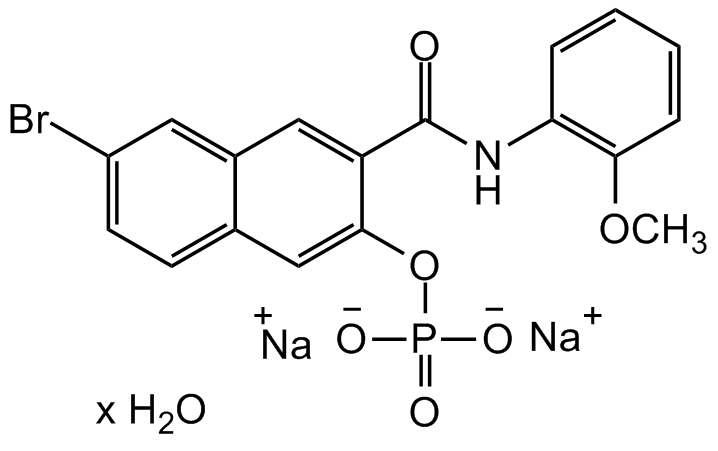Naphthol AS-BI phosphate disodium salt hydrate
| Code | Size | Price |
|---|
| CDX-N0244-G001 | 1 g | £184.00 |
Quantity:
| CDX-N0244-G005 | 5 g | £614.00 |
Quantity:
Prices exclude any Taxes / VAT
Overview
Regulatory Status: RUO
Shipping:
AMBIENT
Storage:
Short term storage:-20°C. Long term storage:-20°C.
Images
Documents
Further Information
Alternate Names/Synonyms:
2-Naphthalenecarboxamide; 7-Bromo-N-(2-methoxyphenyl)-3-(phosphonooxy)-, disodium salt hydrate
Appearance:
White to off-white powder.
CAS:
207569-04-8
EClass:
32160000
Form (Short):
solid
Handling Advice:
Keep under inert gas. Very hygroscopic.
InChi:
InChI=1S/C18H15BrNO6P.2Na.H2O/c1-25-16-5-3-2-4-15(16)20-18(21)14-9-12-8-13(19)7-6-11(12)10-17(14)26-27(22,23)24;;;/h2-10H,1H3,(H,20,21)(H2,22,23,24);;;1H2/q;2*+1;/p-2
InChiKey:
WNPKMQCBZKBNOS-UHFFFAOYSA-L
Long Description:
Chemical. CAS: 207569-04-8. Formula: C18H13BrNNa2O6P . xH2O. MW: 496.16 (anhydrous basis). Naphthol AS-BI-phosphate is a fluorogenic substrate for acid and alkaline phosphatases. Naphthol AS-BI-phosphate is converted to naphthol AS-BI (N-ASBI) displaying excitation/emission spectra of 405/515nm. N-ASBI fluorescence is a quantitative marker of acid and alkaline phosphatase activity. Acid and alkaline phosphatases are often used as clinical markers of disease, since the concentration of human acid and alkaline phosphatases undergo pronounced changes in particular diseases, resulting in unusually high or low concentrations.
MDL:
MFCD00150774, MFCD00064183 (anhydrous)
Molecular Formula:
C18H13BrNNa2O6P . xH2O
Molecular Weight:
496.16 (anhydrous basis)
Package Type:
Vial
Product Description:
Naphthol AS-BI-phosphate is a fluorogenic substrate for acid and alkaline phosphatases. Naphthol AS-BI-phosphate is converted to naphthol AS-BI (N-ASBI) displaying excitation/emission spectra of 405/515nm. N-ASBI fluorescence is a quantitative marker of acid and alkaline phosphatase activity. Acid and alkaline phosphatases are often used as clinical markers of disease, since the concentration of human acid and alkaline phosphatases undergo pronounced changes in particular diseases, resulting in unusually high or low concentrations.
Purity:
>99% (HPLC)
SMILES:
BrC1=CC=C(C=C(OP([O-])([O-])=O)C(C(NC2=C(OC)C=CC=C2)=O)=C3)C3=C1.O.[Na+].[Na+]
Solubility Chemicals:
Soluble in water (50mg/ml).
Source / Host:
Synthetic
Transportation:
Non-hazardous
UNSPSC Number:
41105331
Use & Stability:
Stable for at least 2 years after receipt when stored at -20°C.
References
(1) V. Maggi & W.L. Chng; Histochemie 7, 267 (1966) | (2) A. Vaughan, et al.; Anal. Chem. 43, 721 (1971) | (3) L.T. Yam; Am. J. Med. 56, 604 (1974) | (4) L. Bell & L. Williams; Histochemistry 60, 85 (1979) | (5) F. Dolbeare & W. Phares; J. Histochem. Cytochem. 27, 120 (1979) | (6) F. Dolbeare; J. Histochem. Cytochem. 27, 1644 (1979) | (7) P.J. Stoward, et al.; Histochemistry 74, 367 (1982) | (8) M. Kimura & I. Ichihara; Histochemistry 82, 519 (1985) | (9) R. Gillitzer, et al.; J. Histochem. Cytochem. 38, 307 (1990) | (10) A.J. Janckila, et al.; J. Bone Miner. Res. 16, 788 (2001) | (11) S.C. Rodig; Cold Spring Harb. Protoc. (2019)



